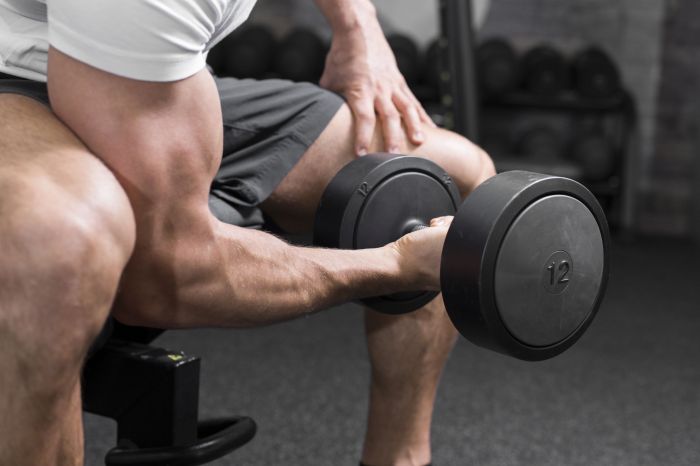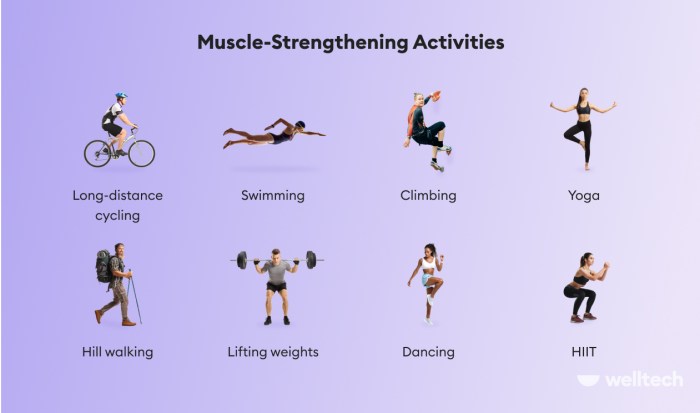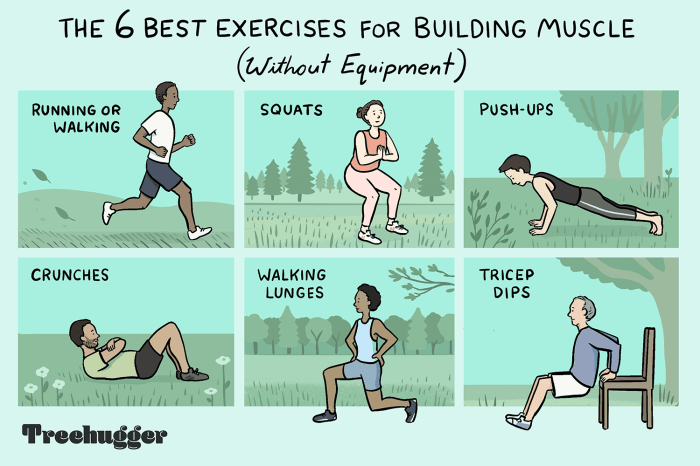Embark on a transformative journey with muscular strength exercises, unlocking the secrets to building a stronger, healthier, and more resilient body. From defining muscular strength to exploring its benefits and demonstrating effective exercises, this comprehensive guide empowers you to achieve your fitness goals.
Muscular Strength Exercises Overview

Muscular strength is the ability of a muscle or group of muscles to exert force against resistance. It is an essential component of overall fitness and plays a crucial role in everyday activities, from lifting heavy objects to maintaining balance.
Types of Muscular Strength Exercises
There are two main types of muscular strength exercises:* Isometric exercises:These exercises involve holding a muscle contraction against a fixed object, such as a wall or a weight.
Isotonic exercises
These exercises involve moving a weight or resistance through a range of motion.
Benefits of Muscular Strength Training
Muscular strength training offers numerous benefits, including:* Increased muscle mass and strength
- Improved bone density
- Reduced risk of injury
- Enhanced balance and coordination
- Improved posture
- Increased metabolism
Examples of Muscular Strength Exercises
Here are some examples of muscular strength exercises for different muscle groups:* Chest:Bench press, push-ups, flyes
Back
Rows, pull-ups, lat pulldowns
Shoulders
Overhead press, lateral raises, front raises
Legs
Squats, lunges, leg press
Core
Planks, crunches, leg raises
| Type of Exercise | Benefits | Examples |
|---|---|---|
| Isometric | Increased muscle endurance | Wall sit, plank |
| Isotonic | Increased muscle mass and strength | Bench press, squats |
Muscular Strength Exercise Techniques

Mastering proper form and technique is crucial for maximizing the benefits of muscular strength exercises while minimizing the risk of injury. Warming up and cooling down are equally important for preparing your body for intense activity and promoting recovery. Safety considerations and injury prevention should always be prioritized.
This comprehensive guide will provide you with the essential knowledge to perform muscular strength exercises effectively and safely, enabling you to achieve your fitness goals.
Proper Form and Technique
Maintaining proper form is paramount for targeting the intended muscle groups, maximizing strength gains, and preventing imbalances or injuries. For each exercise, focus on maintaining a neutral spine, engaging your core, and using a full range of motion. Avoid using momentum or excessive weight, as this can compromise form and increase the risk of injury.
To ensure proper technique, consider consulting with a certified personal trainer or referring to reliable fitness resources. Additionally, utilizing mirrors or video recordings can help you monitor your form and make necessary adjustments.
Importance of Warming Up and Cooling Down
Warming up before exercise prepares your body for the demands of strength training by gradually increasing your heart rate, blood flow, and muscle temperature. This helps reduce the risk of muscle strains, sprains, and other injuries. A warm-up should include light cardio and dynamic stretching exercises that target the muscle groups you’ll be working.
Cooling down after exercise is equally important for promoting recovery. It helps reduce muscle soreness, improve flexibility, and prevent stiffness. A cool-down should include static stretching exercises that target the major muscle groups involved in your workout.
Safety Considerations and Injury Prevention
Safety should always be your top priority during strength training exercises. Here are some key safety considerations:
- Listen to your body and stop if you experience any pain or discomfort.
- Use proper lifting techniques and avoid excessive weight.
- Warm up properly before each workout and cool down afterward.
- Stay hydrated by drinking plenty of water.
- Wear appropriate clothing and footwear for your workout.
- Exercise in a safe environment with adequate space and equipment.
Common Exercises for Major Muscle Groups
Here’s a list of common exercises for each major muscle group:
| Muscle Group | Exercises |
|---|---|
| Chest |
|
| Back |
|
| Shoulders |
|
| Legs (quadriceps) |
|
| Legs (hamstrings) |
|
| Legs (calves) |
|
| Core |
|
Progressing Exercises Over Time
To continue challenging your muscles and making progress, it’s important to gradually increase the intensity of your exercises over time. This can be done by:
- Increasing the weight or resistance.
- Increasing the number of sets or repetitions.
- Decreasing the rest time between sets.
- Introducing more advanced exercises.
Progressing too quickly can increase the risk of injury, so it’s important to listen to your body and make gradual adjustments.
Role of Nutrition in Supporting Muscular Strength Development
Nutrition plays a crucial role in supporting muscular strength development. Here are some key dietary considerations:
- Consume adequate protein to support muscle growth and repair.
- Consume carbohydrates to provide energy for your workouts.
- Consume healthy fats to support hormone production and muscle function.
- Stay hydrated by drinking plenty of water.
A balanced and nutritious diet will help you fuel your workouts, recover effectively, and maximize your strength gains.
Exercise Selection for Muscular Strength

Selecting the right exercises for muscular strength is crucial for optimizing results and minimizing the risk of injury. Different muscle groups respond differently to specific exercises, so it’s essential to understand the benefits and limitations of each exercise to create an effective and personalized exercise plan.
Exercises for Different Muscle Groups
- Chest:Bench press, push-ups, dumbbell flyes
- Back:Pull-ups, rows, lat pulldowns
- Shoulders:Overhead press, lateral raises, front raises
- Biceps:Barbell curls, dumbbell curls, hammer curls
- Triceps:Triceps extensions, skullcrushers, dips
- Quadriceps:Squats, lunges, leg press
- Hamstrings:Deadlifts, Romanian deadlifts, leg curls
- Calves:Calf raises, toe presses, heel raises
Each exercise targets specific muscle groups, allowing for comprehensive strength development. However, it’s important to note that some exercises may have limitations based on individual fitness levels, mobility, and equipment availability.
Exercise Database
To assist in exercise selection, consider creating an exercise database that includes detailed descriptions, proper form, and variations for each exercise. This database can serve as a valuable resource for developing tailored exercise plans.
Personalized Exercise Plan
An effective exercise plan should be personalized based on individual goals and fitness levels. Factors to consider include strength goals, time constraints, and equipment availability. Consulting with a certified fitness professional can help ensure an appropriate and safe plan.
Exercises for Functional Movements
Incorporating exercises that enhance functional movements is essential for improving overall mobility and daily activities. Exercises such as squats, lunges, and deadlifts mimic everyday movements, enhancing strength and coordination.
Home Exercises
For those with limited equipment or time, home exercises can be an effective way to build muscular strength. Bodyweight exercises such as push-ups, squats, and lunges require minimal equipment and can be performed anywhere.
The Role of Macronutrients in Muscular Strength Development

Macronutrients, namely protein, carbohydrates, and fats, play crucial roles in supporting muscular strength development. Understanding their functions and incorporating them adequately into your diet is essential for maximizing gains.
Protein
Protein is the building block of muscle tissue. It provides amino acids, which are the building blocks of proteins, essential for muscle repair and growth. Aim for 1.6-2.2 grams of protein per kilogram of body weight daily.
Carbohydrates, Muscular strength exercises
Carbohydrates provide energy for intense workouts. They replenish glycogen stores in muscles, ensuring you have sufficient fuel during exercises. Aim for 4-6 grams of carbohydrates per kilogram of body weight daily.
Fats
Fats are essential for hormone production and cell function. They support testosterone production, a hormone vital for muscle growth. Aim for 1-1.2 grams of fat per kilogram of body weight daily.
Recovery and Regeneration for Muscular Strength: Muscular Strength Exercises

Recovery and regeneration are essential aspects of muscular strength development. Without adequate rest and recovery, muscles cannot repair themselves and grow stronger. This section will explore the importance of rest and recovery, discuss the use of massage, stretching, and other recovery techniques, and provide tips for managing muscle soreness and fatigue.
Rest is essential for muscle recovery. After a workout, muscles need time to repair themselves and rebuild. This process is known as muscle protein synthesis. During rest, the body releases hormones that promote muscle growth, such as growth hormone and insulin-like growth factor-1 (IGF-1).
It is generally recommended to get 7-9 hours of sleep each night to allow for adequate muscle recovery.
Massage
Massage can be an effective way to promote muscle recovery and reduce soreness. Massage helps to increase blood flow to muscles, which can help to remove waste products and deliver nutrients. Massage can also help to break up muscle knots and tension, which can improve range of motion and reduce pain.
Stretching
Stretching is another important recovery technique. Stretching helps to improve flexibility and range of motion, which can reduce the risk of injury and improve performance. Stretching can also help to reduce muscle soreness and stiffness.
Other Recovery Techniques
In addition to massage and stretching, there are a number of other recovery techniques that can be helpful, including:
- Foam rolling: Foam rolling is a self-massage technique that can help to break up muscle knots and tension.
- Ice baths: Ice baths can help to reduce inflammation and muscle soreness.
- Compression garments: Compression garments can help to improve blood flow and reduce swelling.
- Nutritional supplements: Some nutritional supplements, such as protein powder and creatine, can help to promote muscle recovery and growth.
Tips for Managing Muscle Soreness and Fatigue
Muscle soreness and fatigue are common side effects of strength training. Here are a few tips for managing muscle soreness and fatigue:
- Listen to your body: If you are experiencing severe muscle soreness or fatigue, it is important to rest and allow your muscles to recover.
- Stay hydrated: Dehydration can worsen muscle soreness and fatigue. Be sure to drink plenty of fluids before, during, and after your workouts.
- Eat a healthy diet: Eating a healthy diet that is rich in protein and carbohydrates can help to promote muscle recovery and growth.
- Get enough sleep: Sleep is essential for muscle recovery. Aim for 7-9 hours of sleep each night.
Last Word

Incorporating muscular strength exercises into your routine is not just about aesthetics; it’s about empowering yourself with a body that performs optimally, reduces the risk of injuries, and enhances your overall quality of life. Embrace the transformative power of strength training and witness the profound impact it can have on your physical and mental well-being.
Expert Answers
What is the difference between muscular strength and muscular endurance?
Muscular strength refers to the ability to exert maximum force against resistance, while muscular endurance measures the ability to sustain repeated muscular contractions over time.
How often should I perform muscular strength exercises?
For optimal results, aim for 2-3 sessions per week, targeting different muscle groups each session.
Is it necessary to lift heavy weights for muscular strength development?
Not necessarily. While lifting heavy weights can be effective, you can also build strength using bodyweight exercises, resistance bands, or lighter weights with higher repetitions.
Leave a Reply